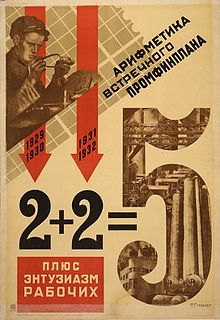4.4 Introduction to Government Policy

A Five Year Plan
The Soviet Union began its first 5-year plan in 1928, an economic strategy to launch the country into the industrial revolution. The strategy involved heavily enforced quotas aimed at developing heavy industry and collectivizing agriculture. The five-year plans had mixed results. Although some of the plans were successful at meeting their goals, such as a build-up in military strength, consumer goods were neglected. Collectivism led to famine and the death of millions.
So far, we have looked at our competitive market model with the assumptions of free-market, or no government intervention. Five-year plans do not adhere to these assumptions, resembling a command and control economy where the government takes an active role in managing the market. While we won’t go as far as command and control in this topic, we will look at some policies the government might implement and the overall effects they have on the economy.

Read more about the Soviet Five-Year Plans
Why the Government Intervenes
So far, we have assumed that the only players in the market are the government, consumers, and firms. This means that market surplus (consumer surplus + producer surplus + government revenue/expenditure) is our sole measure of efficiency.
We have already learned that competitive markets maximize market surplus. This means that any government intervention that changes our equilibrium will inevitably decreases market surplus, resulting in deadweight loss and an inefficient outcome.
If intervention leads to an inefficient outcome, why would the government intervene? Several reasons are outlined below
1. Government Revenue
The government may decide to implement a policy to generate revenue. When we explore taxes, we will see that policies that generate revenue in inelastic markets are especially appealing.
2. Politics
Not all policy is good for society. Special interest groups will sometimes get what they ask for, even if their demands create inefficiencies. Sometimes politicians care more about what will get them votes, than what is good for society.
3. Equity
The government does not always prioritize efficiency. Policies like price ceilings are often intended to help consumers in low-income brackets. Equity is a topic that is explored in more depth in upper level economics. Efficient outcomes can result in a small group accumulating all the wealth. Often this is not viewed as the best outcome.
4. Externalities
In Topic 5, we will see that not all costs are incorporated in our models. For our gasoline market, why did we not consider pollution? There are many externalities and external costs that are not accounted for by firms and consumers. Once these are incorporated into our model, there are clear arguments to be made for government intervention.
Policy Implements
There are many different policies that governments can use to alter the market. Some are much more complicated than others, but many fall into four broad classes we will explore in detail:
-
- Price Controls
- Quantity Controls
- Taxes and Subsidies
- Tariffs

